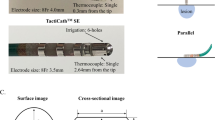Abstract
Lesion sizes and quality are crucial for successful catheter ablation procedures. We sought to test the influence of catheter orientation towards the endocardial surface on lesion formation in bovine myocardium by using an open-irrigated laser ablation catheter. Continuous wave 1064-nm laser catheter applications at 15 W (4.5 W/mm²)/30 s, (135 J/mm²), irrigation flow 30 mL/min, were aimed at the left ventricular endocardial surface of bovine myocardium. The catheter was kept in vertical, in slanting (67.5°, 45°, 22.5°), and in flat positions; in flat position, also 60 s of radiation times were applied (n = 10, each). Lesions were evaluated morphometrically. Maximum depth of lesion was achieved with the catheter in a vertical orientation. Catheter inclination of <22.5 showed a highly significant decrease of lesion depth from 5.6 ± 1.1 to 3.7 ± 0.5 mm (p = 0.0001). In a flat catheter position, laser radiation of 30 s achieved the smallest lesions. However, after 60 s of radiation, the flat lesions were similar in depth (p = 087) and were larger in width (p = 0.0004) and in volumes (p = 0.0025) as compared to the lesions achieved with the catheter in vertical position after 30 s of radiation. Steam-pop with intramural cavitation or tissue vaporization with crater formation did not occur. Longer radiation times can achieve larger lesions regardless of catheter orientation. Catheter orientation is not a major determinant for laser ablation lesion size and quality, and a steerable support may not be needed when using the open-irrigated electrode-laser mapping and ablation (ELMA) catheter RytmoLas.




Similar content being viewed by others
References
Weber HP, Heinze A, Hauptmann G, Ruprecht L, Unsoeld E (1997) In-vivo temperature measurement during transcatheter endomyocardial Nd:YAG laser irradiation in dogs. Lasers Med Sci 12(4):352–356
Splinter R, Hooper B (2007) Introduction to biomedical optics. CRC Press/Taylor & Francis, Boca Raton
Vincent GM, Fox J, Benedick GA, Hunter J, Dixon GA (1987) Laser catheter ablation of simulated ventricular tachycardia. Lasers Surg Med 7(5):421–425
Weber HP, Sagerer-Gerhardt M (2014) Electrocardiographic monitoring of myocardial lesion formation during laser catheter ablation in a dog model. J Innov CRM 5:1641–1649
Weber HP, Sagerer-Gerhardt M (2015) Monitoring of laser effects on the conduction system by using and open-irrigated electrode-laser mapping and ablation catheter: laser catheter mapping. Europace 17:664–670
Weber HP, Sagerer-Gerhardt M (2013) Open-irrigated laser catheter ablation: relationship between the level of energy, myocardial thickness, and collateral damages in a dog model. Europace 16:142–148
Saksena S (1989) Catheter ablation of tachycardias with laser energy: issues and answers. PACE 12:196–203
Keane D, Ruskin JN (1999) Linear atrial ablation with a diode laser and fiber optic catheter. Circulation 100(14):e59–e60
Boulnois J-L (1986) Photophysical processes in recent medical laser developments: a review. Lasers Med Sci 1:47–66
Ikeda A, Nakagawa H, Weber H, Sagerer-Gerhardt M, Weber D, Sharma T, Pitha JV, Lazzara R, Jackman WM (2011) Open-irrigated laser catheter produces deep lesions without thrombus or steam pop. Heart Rhythm 8(5):262, Supplement, PO1-83
Weber H, Sagerer-Gerhardt M (2013) Open-irrigated laser catheter ablation produces flow-dependent sizes of lesions. PACE 36:1132–1137
Weber H, Sagerer-Gerhardt M (2014) Open-irrigated laser catheter ablation: influence of catheter irrigation and of contact and noncontact mode of laser application on lesion formation in bovine myocardium. Lasers Med Sci 29:1183–1187
Cochet H, Sacher F, Chaumeil A, Jais P (2014) Steam pop during radiofrequency ablation. Imaging features on magnetic resonance imaging and multidetector computed tomography. Circ Arrhythm Electrophysiol 7:595–660
Weber H, Heinze E, Enders S, Ruprecht L, Unsoeld E (1997) Laser versus radiofrequency catheter ablation of ventricular myocardium in dogs: a comparative test. Cardiology 88:346–352
Fisher JC (1993) Photons, physiatrics, and physicians: a practical guide to understanding interaction of laser light with living tissue: part II: basic mechanisms of tissue destruction by laser beams. J Clin Laser Med Surg 6:291–303
Juri H, Rubio M, Germanier A et al (1993) A comparative study of caloric profiles produced by Nd:YAG laser radiation and infrared incoherent light on an experimental bovine tissue. J Clin Laser Med Surg 11:251–253
Splinter R, Svenson RH, Littmann L et al (1995) Myocardial temperature during in vivo endocardial Nd-YAG laser irradiation. J Clin Laser Med Surg 13:61–68
Sagerer-Gerhardt M, Weber H (2015) Open-irrigated laser catheter ablation: influence of catheter-tissue contact force on lesion formation. J Interv Card Electrophysiol 42:77–81
Author information
Authors and Affiliations
Corresponding author
Ethics declarations
Funding sources
This study was supported in part by the LasCor GmbH Laser Medical Devices Taufkirchen, Taufkirchen, Germany.
Conflict of interest
The authors declare that they have no conflict of interest.
Rights and permissions
About this article
Cite this article
Sagerer-Gerhardt, M., Weber, H.P. Influence of catheter orientation on lesion formation in bovine myocardium by using an open-irrigated laser ablation catheter. Lasers Med Sci 31, 1333–1338 (2016). https://doi.org/10.1007/s10103-016-1980-1
Received:
Accepted:
Published:
Issue Date:
DOI: https://doi.org/10.1007/s10103-016-1980-1




